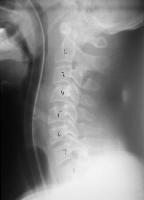Background
Cervical spine fractures lead to substantial morbidity and mortality. Neck injury in athletes can quickly end or change the future of an athlete. Failure to properly recognize and provide early care in cervical spine fracture cases may lead to devastating complications.[1, 2, 3, 4]
A C3 spinous fracture is depicted in the image below.
 Lateral view of a C3 spinous fracture.
Lateral view of a C3 spinous fracture. For patient education resources, see the Back, Ribs, Neck, and Head Center, as well as Neck Strain, Vertebral Compression Fracture, and Whiplash.
NextEpidemiologyFrequencyUnited StatesThe incidence of all spinal injuries in the United States has been reported at approximately 10,000 cases per year. Nearly 200,000 people in the United States have a history of spinal injuries. These statistics do not differentiate between injuries with fracture and injuries without fracture.[5, 6, 7]
Sports-related activities represent 10-15% of these injuries, and spinal injuries represent 2-3% of all sports-related injuries. Certain sports (eg, American football, diving, gymnastics, skiing, wrestling, rugby, hang gliding, surfing, equestrian events) are more frequently associated with the risk of spinal trauma.[2, 3, 4, 6, 7, 8, 9, 10, 11, 12]
The most common spinal injuries cited in the literature are injuries secondary to contact sports such as football. Nearly 1.2 million high school athletes and 200,000 college and professional athletes participate in football. The National Football Head and Neck Injury Registry contains data on cervical spine injuries as a result of participation in football. A trend can be seen over time, as equipment and helmets improved. The incidence of cervical spine injuries increased until 1976. In that year, antispearing rules were established to prevent the athlete from using the helmet as driving force in tackles. Direct collision created higher axial loads than the neck could withstand, leading to high injury rates. This rule, along with better coaching of blocking and tackling techniques, has resulted in a significant decrease in the number of spinal injuries.[10]
Diving is often cited as another significant cause of cervical spine injuries. Injuries resulting from diving are often associated with devastating outcomes. Diving rules (eg, depth of starting areas) and proper technique have lowered the probability of injury during supervised athletic events. However, unsupervised swimming and diving into shallow water present significant risks. Public awareness of this problem has led to the development of special awareness programs, but the risk of injury remains high.
PreviousNextFunctional AnatomyThe human spine serves to provide structural support and bony protection of the spinal cord. The cervical spine consists of 7 bony vertebrae separated by flexible intervertebral discs. They are joined together by an intricate network of ligaments, which helps form the normal lordotic curve of the cervical neck.[13]
The spinal column can be divided into 2 separate columns based on function and injury patterns. The anterior column consists of the bodies of the vertebrae, intervertebral discs, and the anterior and posterior longitudinal ligaments. The function of the vertebral body is to support weight. The posterior column contains the spinal canal and consists of the pedicles, laminae, articulating facets, and transverse and spinous processes. These structures form the vertebral arch, which encloses the vertebral foramen and protects the neural tissues.
The arch is formed by bilateral pedicles that are oriented posteriorly and join 2 laminae. The spinous process arises posteriorly from the vertebral arch. The cervical transverse processes and 4 articular processes also arise from the arch. The cervical transverse processes are unique to the vertebral column with an oval foramen transversarium. The vertebral arteries pass through these foramina. The posterior column also includes a group of ligaments including the supraspinous, infraspinous, interspinous, and nuchal ligaments.
The first 2 cervical vertebrae are atypical in form and function. The next 5 vertebrae are all similar in structure and function. The atlas, C1, is a ring-shaped bone that supports the skull. Two concave, superior articular facets articulate with the occipital condyles. The atlas does not have a body or spinous process. The atlas has an anterior and posterior arch, each with a tubercle and lateral mass. The axis, C2, is the strongest cervical vertebrae. The atlas rotates on 2 large articulating surfaces. The odontoid process (dens) projects superiorly from the C2 body and is the bony structure that the atlas rotates on. The odontoid process is held in place by the transverse ligament of the atlas.
PreviousNextSport-Specific BiomechanicsContact sports, falls, and diving in sports may lead to vertebral stress and fractures. Sports that involving tackling can increase exposure to mechanisms causing fractures.
PreviousProceed to Clinical Presentation , Cervical Spine Acute Bony Injuries in Sports Medicine






0 comments:
Post a Comment
Note: Only a member of this blog may post a comment.